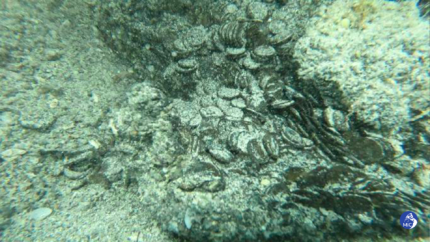 An enormous deposit of tens of thousands of coins from the first half of the 4th century has been discovered on the seabed off the northeastern coast of Sardinia. They are in exceptional condition, with only four suffering conspicuous damage and even they are still legible enough to read their inscriptions and determine their age.
An enormous deposit of tens of thousands of coins from the first half of the 4th century has been discovered on the seabed off the northeastern coast of Sardinia. They are in exceptional condition, with only four suffering conspicuous damage and even they are still legible enough to read their inscriptions and determine their age.
The first coins were discovered by a recreational diver who spotted the glint of metal in the shallow waters near the coast. He reported the find to the authorities, and the next day underwater archaeologists from the Superintendency of Archaeology, Fine Arts and Landscape of Sassari and Nuoro and the Cultural Heritage Protection unit of the Carabinieri explored the seabed at the find site.
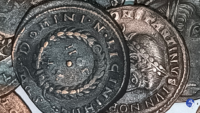 The divers recorded two main areas of coin dispersal in a large sandy area between the beach and the seagrass offshore. Archaeologists believe the topography of the seabed in that area suggests the remains of a shipwreck may be under the seagrass and sand. Fragments of amphorae manufactured in Africa and the Near East that likely came from a wrecked ship were also found among the coins.
The divers recorded two main areas of coin dispersal in a large sandy area between the beach and the seagrass offshore. Archaeologists believe the topography of the seabed in that area suggests the remains of a shipwreck may be under the seagrass and sand. Fragments of amphorae manufactured in Africa and the Near East that likely came from a wrecked ship were also found among the coins.
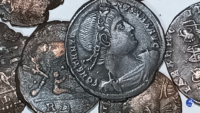 The coins are follis (also known as nummi), bronze coins with a thin top layer of silver introduced by Diocletian in 294 A.D. By the time the coins in the Sardinian sea were produced, currency had been debased several times and the silver content was all but nil. They were widely used throughout the empire. In 2013, a massive hoard of 22,888 follis was discovered by a metal detectorist in Seaton Down, Devon, England. It was fifth largest coin hoard ever found in England. This find beats the Seaton Down hoard by at least 10,000. An initial estimate of the coin numbers based on the weight of the find places it at between 30,000 and 50,000.
The coins are follis (also known as nummi), bronze coins with a thin top layer of silver introduced by Diocletian in 294 A.D. By the time the coins in the Sardinian sea were produced, currency had been debased several times and the silver content was all but nil. They were widely used throughout the empire. In 2013, a massive hoard of 22,888 follis was discovered by a metal detectorist in Seaton Down, Devon, England. It was fifth largest coin hoard ever found in England. This find beats the Seaton Down hoard by at least 10,000. An initial estimate of the coin numbers based on the weight of the find places it at between 30,000 and 50,000.
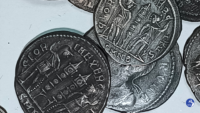 So far, the coins excavated date to between 324 and 340 A.D., minted in the last year of the reign of Licinus and the ascension of Constantine the Great as sole emperor through Constantine’s death in 337 A.D. and the contentious co-rule of his three sons, Constantine II, Constantius II, Constans I. Coins from almost every mint active in the empire at that time are represented.
So far, the coins excavated date to between 324 and 340 A.D., minted in the last year of the reign of Licinus and the ascension of Constantine the Great as sole emperor through Constantine’s death in 337 A.D. and the contentious co-rule of his three sons, Constantine II, Constantius II, Constans I. Coins from almost every mint active in the empire at that time are represented.
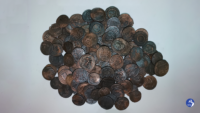 Conservators are still sorting through the huge numbers of coins. Cleaning and conservation of the coins and associated archaeological materials will allow archaeologists to learn more about the context of the finds. There are no current plans to excavate the find site for the remains of the possible shipwreck.
Conservators are still sorting through the huge numbers of coins. Cleaning and conservation of the coins and associated archaeological materials will allow archaeologists to learn more about the context of the finds. There are no current plans to excavate the find site for the remains of the possible shipwreck.
The taxman cometh. The taxman sinketh.
When were they discovered?
The Ministry has not said when the initial discovery was made or subsequent excavation and recovery were completed. Cultural heritage authorities are often deliberately vague on details like precise time and location to keep people from interfering with a site.